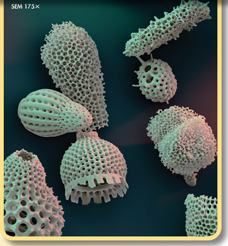
Cercozoa, Foraminiferans, and Radiolarians
There is no single morphological characteristic that unites this diverse trio, but many have extensions of cytoplasm called pseudopods and many produce protective shells. The grouping together of Cercozoa, Foraminifera, and Radiolaria is based almost entirely on molecular analyses and not on morphology.
FORAMINIFERANS
Foraminifera (fawr uh min IF uh ra) produce intricate and beautiful shells that differ from species to species. Slender pseudopods that emerge through tiny holes in the shell enable them to capture food, including bacteria. As many as 4000 species exist.

Peneroplis pertusus has a spiral-shaped shell.
CERCOZOA
Members of this clade are common in soil, where they feed on bacteria as well as decaying organic matter. Many have flagella, and some produce scales made of silica that protect their surfaces.
RADIOLARIANS
These organisms have an intricate structure in which the nucleus is found in an inner region of the cell known as the endoplasm. The outer portion of the cell, known as the ectoplasm, contains lipid droplets and vacuoles. These organisms sometimes form symbiotic relationships with photosynthetic algae, from which they obtain food.

Radiolarian shells are composed of silica or strontium sulfate.
• A Look Back in Time
Foraminiferan Fossils
Ancient Climates Revealed
Abundant fossils of foraminiferans have been found in sediments dating to the Cambrian period (560 million years ago). For decades, oil companies have taken advantage of these ancient fossils to locate the sediments most likely to contain oil, but now there is another use for them—measuring the sea temperature of ancient Earth. Foraminiferans take dissolved oxygen from seawater to make the calcium carbonate (CaCO3) in their shells, and when they do so, they take up two isotopes of oxygen, 16O and 18O. Because water made from 16O is less dense, more of it evaporates into the atmosphere when the seas are warm—increasing the amount of 18O in the remaining seawater, and in the fossil shells. The ratio between 16O and 18O in these fossils allows scientists to study the history of seawater temperature, as shown in the graph above.

Table of Contents
- Formulas and Equations
- Applying Formulas and Equations
- Mean, Median, and Mode
- Estimation
- Using Measurements in Calculations
- Effects of Measurement Errors
- Accuracy
- Precision
- Comparing Accuracy and Precision
- Significant Figures
- Calculating With Significant Figures
- Scientific Notation
- Calculating With Scientific Notation
- Dimensional Analysis
- Applying Dimensional Analysis




